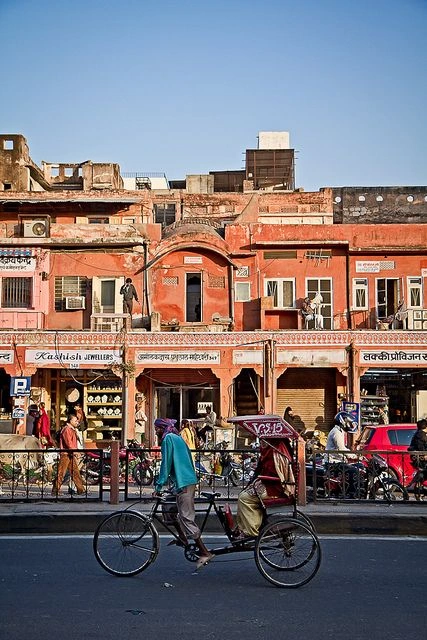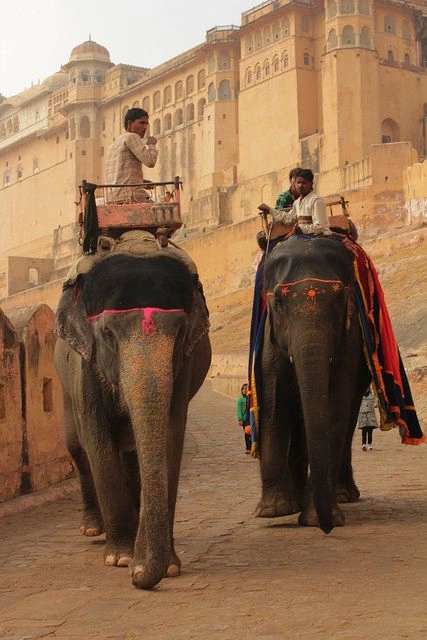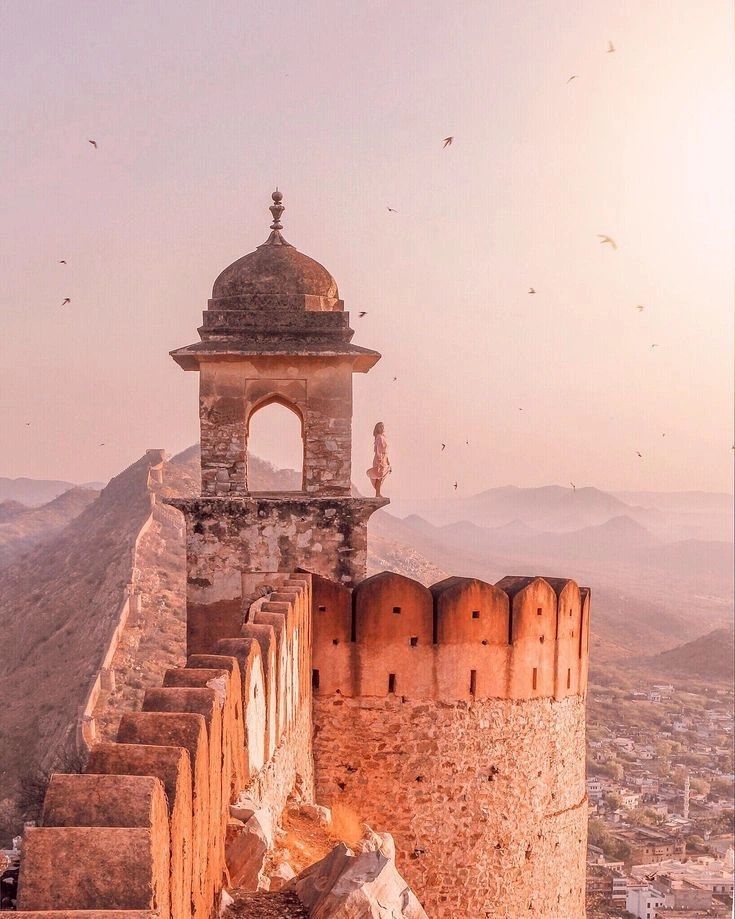In the very center of Rajasthan, where the golden sands of our westernmost state melt like an artist’s palette into the crimson colors of culture and history is Jaipur – the “Pink City.” A name spoken of in hushed tones, stirring visions of grand forts, bewitching palaces, vibrant bazaars, and a long-standing heritage of Rajputana courage and creativity. Jaipur stands as a colorful, thriving canvas painted with hues of Rajputana legacy, artisanal masterpieces, and a contemporary vibe that magnetizes every traveler lingering inside its scarlet-hued forts.
Founded in 1727 by the visionary ruler, astronomer, and scholar Maharaja Sawai Jai Singh II, Jaipur was one of the first Indian cities to be artistically and strategically planned as per the principles of Vastu Shastra (the ancient Indian art of architecture). Combined with its grid-like layout, wide avenues, and the varying shades of pink that adorn many of its buildings, the result is an alluring and pleasantly unusual urban landscape. That intense forethought is a testament to the forward-looking ideals of its founder, who wanted to build a city that was not just beautiful, but a beacon of trade, culture, and enlightenment.

For over 300 years, Jaipur has been a celebration of the wealth, technology, and creativity of the Rajput monarchical dynasty. Its majestic forts and palaces — each a marvel of Rajput and Mughal architecture — recount stories of valor, passion, and opulence. The city’s bustling markets, which spill over with bright silks, shimmering gems, and age-old arts, are a dizzying kaleidoscope of color and sound, providing insight into the masterful artisanship that has long reigned here. To experience Jaipur is to step into a living canvas of history, where each turn reveals a new narrative and each view is a masterpiece just waiting to be painted. Allow us to take you into the most bewitchingly beautiful facets that make Jaipur an undeniable treasure trove of experiences.
Monuments of Majestic History
His Highness Maharaja Sawai Jai Singh II, the ruler of this vibrant city, had each of these majestic forts built atop rocky hills that now cradle the city’s skyline, bridging an ethereal connection to a golden age that once flourished here. These engineering miracles are monuments to the strategic and artistic genius of Rajput rulers.
Amer Fort (Amber Fort): A Hilltop Majesty Nestled on the rugged Aravali hills, roughly 11 kilometers from the city of Jaipur lies the mythic Amber Fort, a stunning amalgamation of Rajput architecture. Its honey-colored sandstone and white marble architecture embodies an extravagant flourished mixture of Rajput and Mughal styles. The fort complex, best explored on foot after arriving via a jeep or elephant ride up the hill, features impressive palatial structures, courtyards, and gardens. The Sheesh Mahal (Mirror Palace) with its stunning mirror work, and the Diwan-i-Aam (Hall of Public Audience) are a few of its architectural gems. The fort’s story is as intriguing as its design, chronicling the exploits of Kachwaha Rajput kings and their myriad friendships and feuds. Deeply rooted stories of struggle, romance, and valor are beautifully presented during a dramatic sound and light show that kicks off each evening at the fort as it magically transports you through the colorful tapestry that was for life.

Nahargarh Fort (the Abode of Tigers) Standing sentinel atop the rugged Aravali Hills, which cradle the Pink City of Jaipur, Nahargarh Fort serves as a dramatic backdrop to this sprawling metropolis and is a popular spot to catch jaw-dropping views of the Amber Fort illuminated by the setting sun. The fort later became a retreat for the royal family. Madhavendra Bhawan, a series of identical suites constructed for the royal harem, is a remarkable specimen of this architecture. The fort’s high ground and strategic location earned it a key role in Jaipur’s defense system. Today, it is a loved sanctuary for catching visions of the sunset. It provides a window into the city’s original means of defense.
Standing on top of the “Cheel ka Teela” (Hill of Eagles), facing Amber Fort, Jaigarh Fort was constructed mainly for defense. It’s home to the Jaivana cannon, at one time the largest wheeled cannon on Earth. The fort’s immense walls, massive courtyards, and the once-imposing armory, now overrun with shrubs and black-faced monkeys, reveal the military importance of the Rajput rulers. A secret tunnel connected Jaigarh to the neighboring Amber Fort, reflecting their military and strategic interdependence. The fort features remarkable views of Amber Fort and the Aravalli landscape.
The Idyllic Fortresses: Remnants of Regal Majesty
Jaipur’s rhythm runs through the stunning Rajput palaces, each a reflection of the overwhelming artistic aesthetic, culture, and opulence of the erstwhile royal clans. These architectural masterpieces provide an insight into the majestic life of the Rajput rulers.
City Palace: A Royal Residence and Museum Located in the center of the Old City, the City Palace is still inhabiting the royal residence. Today, the City Palace is a sprawling complex containing 7 separate courtyards, gardens, and structures. A portion of the palace still serves as the home for the Jaipur royal family, the remainder a museum displaying an opulent assortment of royal costumes, textile arts, armory, and miniature paintings. Architectural gems include the Chandra Mahal, Mubarak Mahal, and Pritam Niwas Chowk with its elaborately painted gates symbolizing the four seasons. The palace remains an exquisite, living testament to Jaipur’s extraordinary royal heritage and dazzling artistic patronage.
Hawa Mahal (Palace of Winds): An Architectural Marvel One of Jaipur’s most famous and photogenic landmarks, the Hawa Mahal is a stunning five-story pyramidal structure bejeweled with 953 small windows or “jharokhas.” Constructed in 1799 by Maharaja Sawai Pratap Singh, its beautiful exterior façade made it possible for royal females to watch the everyday life and processions of the street beneath without being seen. One cannot forget the architectural ingenuity of the Hawa Mahal, which was designed to capture the breeze and maintain cool interiors. Its fragile honeycomb-like framework is a photographer’s dream and an expression of the very best of Jaipur’s architectural ingenuity.

Nestled in the midst of the Man Sagar Lake, Jal Mahal looks like a fairy tale. This enormous five-story palace, with four stories under the surface of the lake’s surface, presents a magnificent but peaceful sight. Originally constructed in the mid-1700s as a royal hunting lodge. Though access within the palace walls is not yet open to visitors, a short boat ride across the lake provides a jaw-droppingly beautiful glimpse at the palace architecture set against the rising Nahargarh hills. With its stunning natural location and distinct architectural style, the palace is a mesmerizing sight — particularly at sunset.
Architectural and Astronomical Marvels
Beyond forts and palaces, Jaipur may be known best for a pair of architectural and astronomical wonders, which speak to the scientific curiosity and artistic vision of Jaipur’s martial kings.
Jantar Mantar is an astronomical observatory constructed by Maharaja Sawai Jai Singh II. It is home to a collection of nineteen large architectural astronomical instruments, built to measure time, demonstrate the apparent motion of celestial bodies, and predict eclipses. The Samrat Yantra, the world’s largest sundial, is the most recognizable structure in the complex. Jantar Mantar is a reminder of Maharaja Jai Singh II’s passion for astronomy and his forward-thinking scientific acumen. Whether by examining its elaborate tools or learning about its groundbreaking discoveries, there’s a spectacular look at the 18th century’s astronomical understanding waiting at the observatory.
The Albert Hall Museum is the oldest museum in the Rajasthan state and an architectural masterpiece. Constructed in the Indo-Saracenic style made popular during British rule, its opulent arches and domes contain one of the country’s most valuable collections of artifacts, including stone carvings, paintings, textiles, and an Egyptian mummy. The museum is a deep dive into the art, craft, and history of Rajasthan, with sweeping views of cultures around the world. During the evening hours, its vibrant lit exterior is an impressive spectacle.
Vibrant Bazaars—A Shopper’s Paradise
Jaipur’s vibrant markets are a sensory feast, bursting with vivid silks, ornate gold and silver jewelry, classic handicrafts, and fragrant spices. Wandering through these colorful bazaars becomes one of the most memorable experiences in Jaipur.
One look at its name and you could assume that Johari Bazaar is the paradise for beautiful jewelry, especially Kundan and Meenakari work. Sparkling gemstones, elaborate gold and silver floral and peacock motifs, and traditional Rajasthani khichdi baley jewelry designs draw buyers from afar. It is the overall creativity that jumped out at me.

These markets are popular for their colorful textiles, as well as block-printed fabrics, bandhani (tie-dye), and traditional Rajasthani attire. You’ll want to shop for handicrafts, leather goods, and other locally made souvenirs. Negotiating is typical and it makes shopping a lot more interesting!
Tripolia Bazaar, Jaipur, Rajasthan Tripolia Bazaar, famous for its ironware, brassware, and carpets, is a shopper’s paradise. You’ll be amazed at the exquisitely carved decorative objects for the home and the famous Rajasthani carpets, woven in lovely geometric patterns and brilliant colors.
This old bazaar teems with bustling life and offers mouthwatering snacks as well as marble handicrafts and sculptures. Here, you will see complexly carved idols and decorative items as well as traditional Rajasthani footwear (juttis).
More Than the Monuments: Discovering the Heartbeat of Jaipur
To truly enjoy the alluring charm that lies in Jaipur’s soul, one needs to dive deep into its culture, traditions, and local life.
Galtaji Hindu Temple (Monkey Temple) Enclaved by rocky hills, the Galtaji Temple pilgrimage destination features several natural springs, sacred kunds (water tanks), and temples. It’s home to the world’s largest monkey population, earning it the widely-used nickname “Monkey Temple.” The intricate architecture of the temples and the picturesque natural surroundings make it truly a unique and inspiring place to visit.
Sisodia Rani Bagh—A Royal Garden Retreat: Built by Maharaja Sawai Jai Singh II for his second wife, Sisodia Rani, this picturesque garden maintains tiered levels, fountains, pavilions and murals portraying scenes from the life of Lord Krishna. Second, the park provides a peaceful retreat from the hectic urban environment.
Hidden inside the City Palace complex, the Govind Dev Ji Temple is one of the royal family’s temples dedicated to Lord Krishna. It’s of deep religious importance to the native people there, and participating in their daily prayers and rituals is an energetic cultural experience.
Chokhi Dhani: A Rajasthani Cultural Extravaganza For a truly cultural experience, Chokhi Dhani is a must-visit. This ethnic village resort recreates the authentic rural Rajasthani atmosphere, culture, and experience through folk music, dance performances, traditional Rajasthani curry, camel rides, elephant rides, handicrafts stalls, and more!
Also check:- India’s top ten richest people in 2025
Getting to Jaipur
The ideal time to visit Jaipur would be the winter months (October to March) when Jaipur experiences pleasant weather. It feels much cooler and perfect for sightseeing. Summers (April through June) are sizzling. Jaipur hosts an international airport and is connected by rail and road to all major cities of India. The taxis, auto-rickshaws, and ride-sharing services are incredibly efficient, so once you’re out of the conference, travel around the city will be a breeze.
Accommodation in Jaipur runs the gamut from five-star heritage hotels, which were palaces where kings and queens once lived, all the way to backpacker-friendly guesthouses.
Jaipur: A City That Lives and Breathes History
To meander down the pink-washed boulevards of Jaipur is to shoulder history’s greatest novel. The magnificent forts ferry you through echoing stories of bravery and splendor, the stunning palaces echo melodious ballads of lover kings and artist empires and the colorful, cacophonous bazaars throb with the heady electricity of its people and their time-honored arts. Jaipur is more than a mere tourist destination dotted with centuries-old monuments. It’s a pulsating, throbbing living and breathing testament to the Jaipur rich cultural heritage of Rajasthan. Its unique fusion of artistic elegance, rich cultural rituals, and the open-heartedness of its residents combined to form a magical destination that lingers in the memory of each traveler long after they have escaped its rosy confines. A city where the past and present are completely blended, Udaipur provides a perfect getaway into the glorious epicenter of Rajputana glory.

